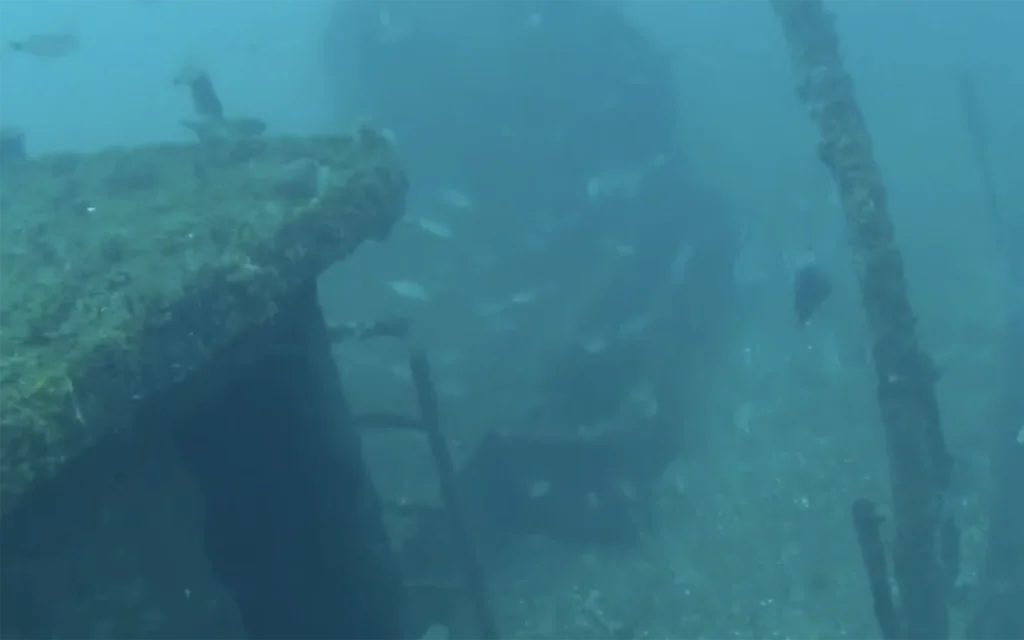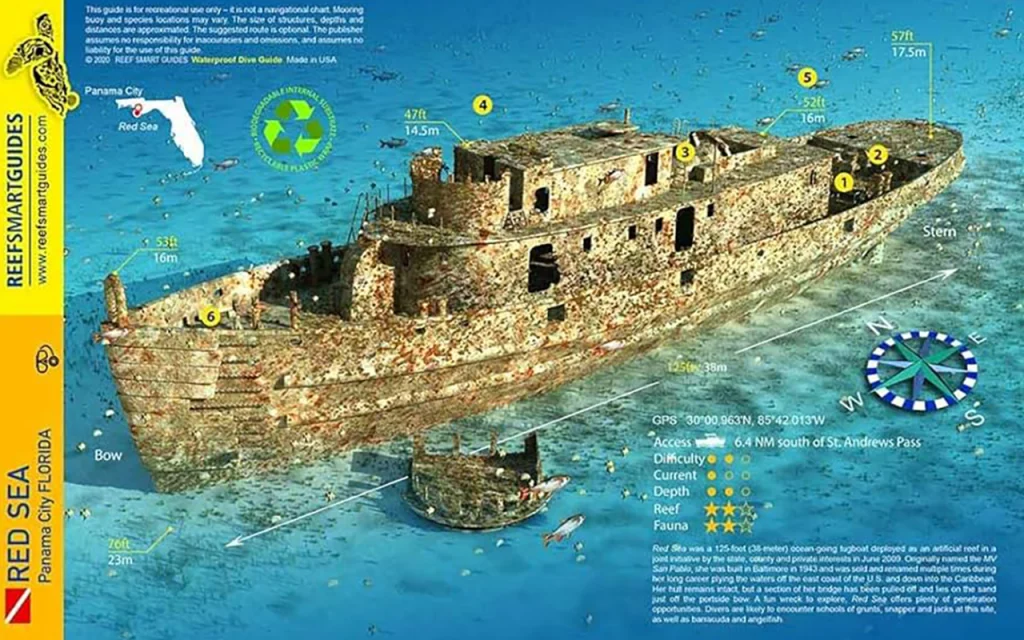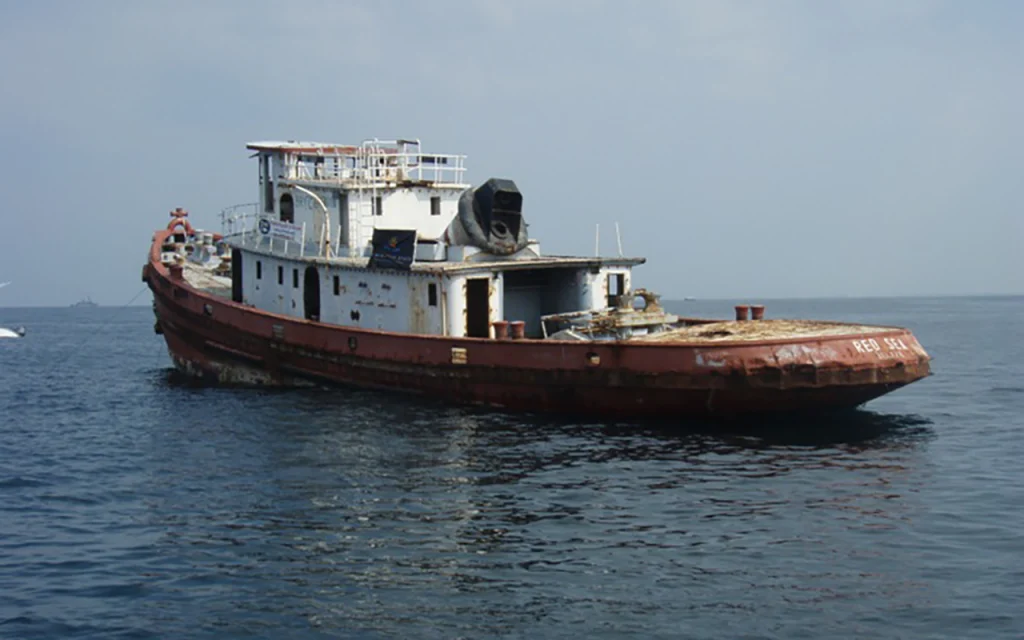Table of Contents

While not as massive as some Florida wrecks like the Oriskany, the Red Sea Tug’s accessible depth, interesting structure, and position as part of a larger artificial reef program make it a valuable addition to Florida’s diverse underwater attractions for divers.
Article at a Glance
- Historical Background: The Red Sea Tug, built in the 1970s in Philadelphia, served as a working tugboat for over two decades before being sold to foreign owners and eventually becoming an artificial reef.
- Intentional Sinking: On June 24, 2009, the tug was intentionally sunk off Panama City Beach, Florida, as part of a community effort to create a new underwater habitat for marine life and a diving attraction.
- Diving Accessibility: With a maximum depth of 74 feet (22 meters) and a relief of 36 feet (11 meters), the Red Sea Tug is accessible to recreational divers, making it a popular dive site in the Gulf of Mexico.
- Location Coordinates: The wreck is located approximately 5.5 miles offshore, with coordinates of 30° 00.958′ N and 85° 42.003′ W, placing it in the heart of the “Wreck Capital of the South.”
- Marine Ecosystem: Since its sinking, the Red Sea Tug has developed into a thriving artificial reef, attracting a variety of marine life, including schools of fish, corals, and invertebrates.
- Diving Experience: Divers can explore various parts of the wreck, including the bridge and deck, with opportunities for both exterior exploration and potential penetration dives for trained individuals.
- Local Dive Shops: Several dive shops in Panama City Beach, such as Panama City Diving and Red Alert Diving, offer trips to the Red Sea Tug, providing guided experiences for divers looking to explore this unique underwater site.
Shipwreck Location Coordinates and Depth
Depth
The Red Sea Tug rests at the following depths:
Location Coordinates
The Red Sea Tug is located at:

What Do Scuba Divers Say About This Ship
- It’s considered a popular and accessible dive site off the coast of Panama City Beach, Florida.
- The wreck provides an interesting artificial reef habitat for marine life, making it an attractive spot for divers to explore.
- The maximum depth of 74 feet (22 meters) makes it accessible to many recreational divers.
- Divers can explore various parts of the former tugboat, including the bridge structure.
- The intentional sinking of the Red Sea Tug in 2009 was part of efforts to create new underwater attractions and habitats in the area known as the “Wreck Capital of the South”.
- The wreck’s relatively shallow depth and 36-foot relief (height of structure) provide good opportunities for exploration.
- While specific diver reviews for this wreck are not provided in the search results, artificial reefs like the Red Sea Tug generally attract a variety of marine life, enhancing the diving experience.
- The wreck’s location about 5.5 miles offshore makes it a destination for boat diving trips from Panama City Beach.
What Kind of Marine Life Can Be Found on The Ship
Fish Species
- Schools of barracuda
- Batfish
- Various reef fish species
Invertebrates and Corals
- Soft corals
- Sponges
- Possibly hard corals, though these take longer to establish
Other Marine Life
- Moray eels
- Lionfish (an invasive species in the Gulf of Mexico)
- Glassfish
Ecosystem Development
The Red Sea Tug, sunk in 2009, has likely developed into a thriving artificial reef over the years. As with other artificial reefs in the area:
- The structure provides habitat for a variety of marine species.
- Over time, the wreck becomes encrusted with marine growth, attracting more diverse marine life.
- The wreck creates a complex ecosystem, with different species occupying various niches within and around the structure.
Key Information
| Attribute | Information |
|---|---|
| Name | Red Sea Tug |
| Type | Tugboat |
| Length | 130 feet (39.6 meters) |
| Width | 30 feet (9.1 meters) |
| Location | Off Panama City Beach, Florida |
| Coordinates | 30° 00.958′ N, 85° 42.003′ W |
| Maximum Depth | 74 feet (22 meters) |
| Relief (Height) | 36 feet (11 meters) |
| Sinking Date | June 24, 2009 |
| Purpose | Intentionally sunk as an artificial reef |
| Year Built | 1970s |
| Build Location | Philadelphia |
| Distance from Shore | Approximately 5.5 miles |
| Interesting Features | Bridge structure, potential for interior exploration |
| Marine Life | Various reef fish, potential for coral growth |
| Accessibility | Suitable for recreational divers |
What Makes The Red Sea Tug Shipwreck a Unique Diving Experience
Historical Significance
- Built in Philadelphia in the 1970s, the Red Sea Tug has an interesting backstory of working in US waters for over 20 years before being sold to foreign owners.
- Its journey to becoming an artificial reef involved multiple owners, mechanical failures, and community efforts to fund its sinking.
Intentional Sinking
- The Red Sea Tug was intentionally sunk on June 24, 2009, as part of a project to create an artificial reef.
- This planned sinking allows for a safer and more accessible dive site compared to accidental shipwrecks.
Accessibility
- With a maximum depth of 74 feet (22 meters), the Red Sea Tug is accessible to many recreational divers.
- Its 36-foot (11 meter) relief provides interesting vertical structure to explore.
Location
- Situated off the coast of Panama City Beach, Florida, it’s part of the area known as the “Wreck Capital of the South”.
- Its coordinates (30° 00.958′ N, 85° 42.003′ W) make it a specific destination for divers.
Community Effort
- The sinking of the Red Sea Tug was a community project, with local dive shops contributing funds over several years.
- The Panama City Beach Tourist Development Council ultimately provided the balance of funds needed to complete the project.
Artificial Reef Development
- Since its sinking in 2009, the Red Sea Tug has likely developed into a thriving artificial reef, attracting various marine life.
- As an artificial reef, it provides habitat for fish and other marine organisms, enhancing the local ecosystem.
Diving Experience
- The wreck offers opportunities for both exterior exploration and potential penetration dives for properly trained divers.
- Its relatively recent sinking means divers can observe the ongoing process of a ship transforming into an artificial reef.
How Does The Red Sea Tug Compare to Other Shipwrecks in Florida
Size and Type
- The Red Sea Tug is a 130-foot long, 30-foot wide tugboat.
- This makes it smaller than some of the larger wrecks like the USS Oriskany aircraft carrier, but larger than many other tugboat wrecks in Florida.
Depth and Accessibility
- Maximum depth is 74 feet, with the top at about 40 feet.
- This relatively shallow depth makes it accessible to many recreational divers, unlike deeper technical dive sites.
Age and Condition
- Intentionally sunk in 2009, it’s a relatively recent artificial reef compared to older accidental shipwrecks.
- Being purpose-sunk, it was likely prepared to be safer for divers than accidental wrecks.
Location
- Part of the “Wreck Capital of the South” off Panama City Beach.
- Contributes to the diverse array of wrecks in the Florida Panhandle Shipwreck Trail.
Historical Significance
- Built in Philadelphia in 1929, it has an interesting history as a working tugboat before becoming an artificial reef.
Diving Experience
- Offers both exterior exploration and potential penetration dives for properly trained divers.
- Its upright position provides an easy-to-navigate structure.
Marine Life
- As an artificial reef, it has likely developed a thriving ecosystem over the years, though specific details weren’t provided in the search results.
What is The Full History of This Ship
Origins and Early History
- Built in Philadelphia in the 1970s
- Worked in US waters for over 20 years as a tugboat
Change of Ownership and Mechanical Issues
- Sold to foreign owners after its service in US waters
- While en route to Venezuela under new ownership, it experienced mechanical failure in the Miami River
Journey to Becoming an Artificial Reef
- After the mechanical failure, it was sold several times
- Eventually taken to Stock Island near Key West, Florida
- Came to the attention of Captain Mike Mayers of Atlantis Towing & Salvage
- Mayers presented the possibility of using it as an artificial reef to Mike Gomez of PCDC and Danny Grizzard of FAMI in Panama City Beach
Acquisition and Preparation
- An agreement was reached to buy and sink the Red Sea in early 2007
- A $20,000 deposit secured the wreck in Panama City
- This initial funding came from local dive shops contributing $1 per boat customer and maintaining donation boxes
- The project faced numerous challenges including storms, dockage issues, and cleaning
Community Support
- The City of Panama City allowed free dockage
- A local tugboat company helped move it several times
- Capt. Alan Golden, Bay County Reef Coordinator, provided guidance and had the smokestack cut for clearance
Final Stages and Sinking
- In 2009, the Panama City Beach Tourist Development Council provided the remaining funds needed
- On June 24, 2009, about two years after the project began, the Red Sea was intentionally sunk
Current Status
- Now rests in just over 70 feet of water off the coast of Panama City Beach
- Has become a popular addition to the local wreck diving trail
- Serves as an artificial reef, attracting marine life and divers

What Historical Features Can Still Be Identified on the Red Sea Tug Wreck
- Overall structure: The basic shape and structure of the tugboat is likely still identifiable, including features like the bridge, deck, and hull.
- Mechanical components: Elements like the propeller, rudder, and possibly parts of the engine room may be visible, depending on how the ship was prepared for sinking.
- Accessibility: As an intentionally sunk ship, there may be specially cut openings to allow safer diver access to interior spaces.
- Marine growth: After over a decade underwater, the wreck would be covered in marine growth, which can both obscure and enhance certain features.
- Artifacts: While most removable items are typically stripped before sinking, there may still be fixed elements like gauges, controls, or structural components that hint at the ship’s former use.
- Deck features: Depending on how it was prepared, some deck features like railings, winches, or other equipment specific to tugboats might still be identifiable.
What Safety Measures Are in Place for Divers Visiting the Red Sea Tug
- Depth restrictions: With a maximum depth of 74 feet (22 meters), the wreck is within recreational diving limits, making it accessible to many divers while avoiding extreme depths.
- Recommended training: While not explicitly stated for this wreck, artificial reefs often have recommended minimum training levels for divers, such as Open Water certification or higher.
- Guided dives: Local dive operators likely offer guided dives to the site, providing supervision and local knowledge.
- Mooring buoys: Given its status as an intentionally sunk artificial reef, it’s probable that mooring buoys are in place to prevent anchor damage and provide a secure tie-off point for dive boats.
- Preparation of the wreck: As an intentionally sunk ship, it was likely prepared for diving, with potential hazards removed and possibly some entry/exit points created for safer exploration.
- Local regulations: The wreck is part of the “Wreck Capital of the South” area, which likely has specific diving regulations and guidelines in place to ensure safety and preservation of the sites.
- Dive planning: The known depth and relief of the wreck (36 feet or 11 meters) allows for proper dive planning and gas management.
- Environmental considerations: As an artificial reef, there may be guidelines in place to protect the developing marine ecosystem.
Dive Shops That Provide Diving Trips to This Shipwreck
- Panama City Diving
- Address: 106 Thomas Dr, Panama City Beach, FL 32408
- Phone: (850) 588-8077
- Website: https://panamacitydiving.com
- Red Alert Diving
- Address: 1619 Moylan Rd, Panama City Beach, FL 32407
- Phone: (850) 238-8760
- Website: https://redalertdiving.com/
- Dive Locker
- Address: 1010 Thomas Drive, Panama City Beach, FL 32408
North Florida Wrecks
- USS Oriskany
- USS Massachusetts
- SS Tarpon
- SS Gulf America
- Empire Mica
- USS Chippewa
- Avocet
- Black Bart
- The Vamar
- San Pablo
- USS Narcissus
- The Loftus Wreck
- The Dorothy Louise
- The Mizpah
- MV Janet
- The Eidsvag
- YDT-14 and YDT-15
- USS Strength
- Miss Louise
- The Lulu
- PC-1174
- Three Coal Barges
- USS Accokeek (ATA-181)
- El Dorado
- The Grey Ghost
- The Pete Tide II
- Red Sea Tug





